Steelers theme by MrGrimmz
Download: Steelers.p3t
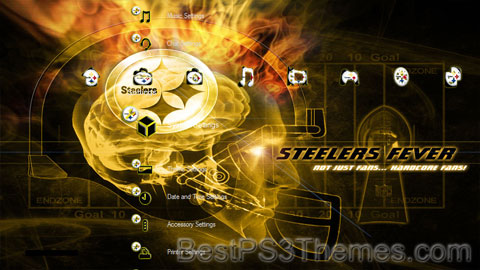
(5 backgrounds)
Redirect to:

The #1 spot for Playstation themes!
Pittsburgh Penguins theme by Rick Rickabaugh
Download: PittsburghPenguins_2.p3t
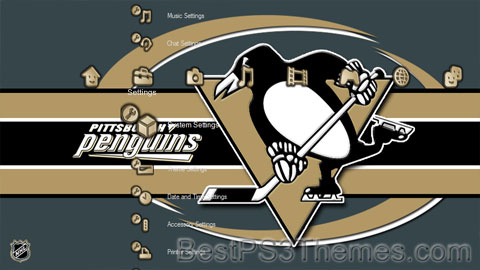
(3 backgrounds)
| Pittsburgh Penguins | |
|---|---|
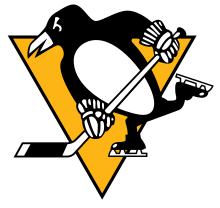 | |
| Conference | Eastern |
| Division | Metropolitan |
| Founded | 1967 |
| History | Pittsburgh Penguins 1967–present |
| Home arena | PPG Paints Arena |
| City | Pittsburgh, Pennsylvania |
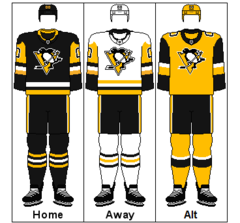 | |
| Team colors | Black, Pittsburgh gold, white[1][2][3] |
| Media | SportsNet Pittsburgh The X (105.9 FM) ESPN Pittsburgh (970 AM) Pittsburgh Penguins Radio Network |
| Owner(s) | Fenway Sports Group Mario Lemieux (minority)[4] |
| General manager | Kyle Dubas |
| Head coach | Mike Sullivan |
| Captain | Sidney Crosby |
| Minor league affiliates | Wilkes-Barre/Scranton Penguins (AHL) Wheeling Nailers (ECHL) |
| Stanley Cups | 5 (1990–91, 1991–92, 2008–09, 2015–16, 2016–17) |
| Conference championships | 6 (1990–91, 1991–92, 2007–08, 2008–09, 2015–16, 2016–17) |
| Presidents' Trophy | 1 (1992–93) |
| Division championships | 9 (1990–91, 1992–93, 1993–94, 1995–96, 1997–98, 2007–08, 2012–13, 2013–14, 2020–21) |
| Official website | nhl |
The Pittsburgh Penguins (colloquially known as the Pens) are a professional ice hockey team based in Pittsburgh. The Penguins compete in the National Hockey League (NHL) as a member of the Metropolitan Division of the Eastern Conference, and have played their home games at PPG Paints Arena, originally known as Consol Energy Center, since 2010. The team previously played at the Civic Arena, which was also known as Mellon Arena from 1999 to 2010, and by its nickname "the Igloo". The Penguins are affiliated with two minor league teams – the Wilkes-Barre/Scranton Penguins of the American Hockey League (AHL) and the Wheeling Nailers of the ECHL.
Founded during the 1967 expansion, the Penguins have qualified for six Stanley Cup Finals, winning the Stanley Cup five times – in 1991, 1992, 2009, 2016, and 2017. Along with the Edmonton Oilers, the Penguins are tied for the most Stanley Cup championships among the non-Original Six teams and sixth overall. With their Stanley Cup wins in 2016 and 2017, the Penguins became the first back-to-back champions in the salary cap era. Several of the team's former members have been inducted into the Hockey Hall of Fame, including co-owner Mario Lemieux, who purchased the Penguins in 1999 and brought the club out of bankruptcy. Lemieux, Jaromir Jagr, Sidney Crosby, and Evgeni Malkin have won the Hart Memorial Trophy while playing for the franchise.
Prior to the arrival of the Penguins, Pittsburgh had been the home of the NHL's Pittsburgh Pirates from 1925 to 1930 and of the American Hockey League's Pittsburgh Hornets franchise from 1936 to 1967 (with a short break from 1956 to 1961). In the spring of 1965, Jack McGregor, a state senator from Kittanning, Pennsylvania, began lobbying campaign contributors and community leaders to bring an NHL franchise back to Pittsburgh. The group focused on leveraging the NHL as an urban renewal tool for Pittsburgh. The senator formed a group of local investors that included H. J. Heinz Company heir H. J. Heinz III, Pittsburgh Steelers' owner Art Rooney and the Mellon family's Richard Mellon Scaife. The projected league expansion depended on securing votes from the then-current NHL owners; to ensure Pittsburgh would be selected as one of the expansion cities, McGregor enlisted Rooney to petition votes from James D. Norris, owner of the Chicago Black Hawks and his brother Bruce Norris, owner of the Detroit Red Wings. The effort was successful, and on February 8, 1966, the National Hockey League awarded an expansion team to Pittsburgh for the 1967–68 season. The Penguins paid $2.5 million ($23.8 million today) for their entry and $750,000 ($6.9 million today) more for start-up costs. The Civic Arena's capacity was boosted from 10,732 to 12,500 to meet the NHL requirements for expansion. The Pens also paid an indemnification bill to settle with the Detroit Red Wings, which owned the Pittsburgh Hornets franchise. The investor group named McGregor president and chief executive officer, and he represented Pittsburgh on the NHL's Board of Governors.[5][6]

A contest was held where 700 of 26,000 entries picked "Penguins" as the team's nickname, sharing its nickname with the athletic department of the newly named Youngstown State University in nearby Youngstown, Ohio. (Youngstown is part of the Penguins' territorial rights to this day, though they did briefly share them with the Cleveland Barons in the mid-1970s.) Mark Peters had the winning entry (which was inspired because the team was to play in the "Igloo", the nickname of the Pittsburgh Civic Arena),[7][8] a logo was chosen that had a penguin in front of a triangle, which symbolized the "Golden Triangle" of downtown Pittsburgh.[7][9] The Penguins' first general manager, Jack Riley, opened the first pre-season camp for the franchise in Brantford, Ontario,[10] on September 13, 1967, playing the franchise's first exhibition match in Brantford against the Philadelphia Flyers on September 23, 1967. Restrictive rules which kept most major talent with the existing "Original Six" teams hampered the Pens, along with the rest of the expansion teams. Beyond aging sniper Andy Bathgate, all-star defenseman Leo Boivin (who had begun his professional career with the Hornets) and New York Rangers' veteran Earl Ingarfield, a cast of former minor leaguers largely manned the first Penguins' team. Several players played for the Hornets the previous season: Bathgate, wingers Val Fonteyne and Ab McDonald, and goaltenders Hank Bassen and Joe Daley. George Sullivan was named the head coach for the club's first two seasons, and McDonald was named the team's first captain.[11]
On October 11, 1967, league president Clarence Campbell and McGregor jointly dropped the ceremonial first puck of the Penguins' opening home game against the Montreal Canadiens.[5] On October 21, 1967, they became the first team from the expansion class to defeat an Original Six team, as they defeated the Chicago Black Hawks 4–2. However, the Penguins went 27–34–13 and finished in fifth place in the West Division, missing the playoffs and ending with the third-worst record in the league. The team's best player proved to be longtime Cleveland Barons AHL goaltender Les Binkley, who recorded a 2.88 goals-against average and was second in the league with six shutouts. Defensive winger Ken Schinkel won the team's sole league honor, being named to represent the Penguins in the NHL All-Star Game. Bathgate led the team in scoring with 59 points but retired at season's end. McDonald, who led the team in goals and was second in team scoring, was also gone at season's end, traded to the St. Louis Blues in exchange for center Lou Angotti.[6]
The next season saw the team slip in the standings amid a sharp drop in form by Binkley, into sixth place and with the league's worst record. Several changes were made to improve the team, resulting in Boivin and several others being traded, and new players—including longtime future Pens star Jean Pronovost—making their debuts. No captain was named to replace McDonald; the team went with four alternate captains.

In the 1969 draft the Penguins selected Michel Briere who, although being chosen 26th, was soon drawing comparisons to Phil Esposito and Bobby Clarke. Joining the team in November, he finished as the second-place rookie scorer in the NHL (behind Bobby Clarke) with 44 points (57th overall), and third on the Penguins. Briere placed second in Calder Memorial Trophy voting for Rookie of the Year honors behind Chicago goaltender Tony Esposito. Briere led Pittsburgh to its first NHL playoff berth since the 1928 Pirates. The Penguins defeated the Oakland Seals in a four-game sweep in the quarterfinals, with Briere scoring the series-clinching goal in overtime. In the semi-final round, defending conference champions St. Louis Blues got the best of the Penguins during six games. Briere led the team in playoff scoring, recording five goals (including three game-winners) and eight points. Tragedy struck the Penguins just days after their playoff heroics. On May 15, 1970, Briere was in a car crash in his native Quebec, suffering brain trauma and slipping into a coma from which he would never recover; he died a year later. His number 21 jersey was never reissued, remaining out of circulation until it was formally retired in 2001.[6]
In the 1970–71 season, the Penguins finished five games out of the playoffs with a 21–37–20 record, the fourth-worst record in the league. Pittsburgh achieved a playoff berth in 1972, only to be swept by the Chicago Black Hawks in the first round. Except for a handful of players like Ken Schinkel, Pronovost, Syl Apps Jr., Keith McCreary, agitator Bryan Watson and goaltender Les Binkley, talent was thin, but enough for the Penguins to reach the playoffs in both 1970 and 1972. The Penguins battled the California Golden Seals for the division cellar in 1974, when Riley was fired as general manager and replaced by Jack Button. Button obtained Steve Durbano, Ab DeMarco, Bob "Battleship" Kelly and Bob Paradise through trades. The personnel moves proved successful, and the team improved to a 28–41–9 record, although they remained nine points away from a playoff berth.
However, in early 1975, the Penguins' creditors demanded payment of back debts, forcing the team into bankruptcy. The doors to the team's offices were padlocked, and it looked like the Penguins would fold or relocate.[12] Around the same time, rumors began circulating that the Penguins and the California Golden Seals were to be relocated to Seattle and Denver respectively, the two cities that were to have been the sites of an expansion for the 1976–77 season.[13] Through the intervention of a group that included former Minnesota North Stars head coach Wren Blair, the team was prevented from folding and remained in Pittsburgh, eventually being bought by shopping mall magnate Edward J. DeBartolo, Sr.

Beginning in the mid-1970s, Pittsburgh iced some powerful offensive clubs, led by the likes of the "Century Line" of Syl Apps, Lowell MacDonald and Jean Pronovost. They nearly reached the Stanley Cup semi-finals in 1975, but were ousted from the playoffs by the New York Islanders in one of the only four best-of-seven-game series in NHL history where a team came back from being down three games to none. As the 1970s wore on, a mediocre team defense neutralized the Penguins' success beyond the regular season. Baz Bastien, a former coach and general manager of the AHL's Hornets, later became general manager. The Penguins missed the playoffs in 1977–78. Bastien traded prime draft picks for several players whose best years were already behind them, and the team would suffer in the early 1980s as a result. The decade closed with a playoff appearance in 1979 and a rousing opening series win over the Buffalo Sabres before a second-round sweep at the hands of the Boston Bruins.[6]
The Penguins began the 1980s by changing their team colors; in January 1980, the team switched from wearing blue and white to their present-day scheme of black and gold to honor Pittsburgh's other sports teams, the Pittsburgh Pirates and the Pittsburgh Steelers, as well as the Flag of Pittsburgh. Both the Pirates and Steelers had worn black and gold for decades, and both had enjoyed world championship seasons. The Bruins protested this color change, claiming a monopoly on black and gold, but the Penguins defended their choice stating that the NHL Pirates also used black and gold as their team colors and that black and gold were Pittsburgh's traditional sporting colors. The NHL agreed, and Pittsburgh could use black and gold. The Penguins officially debuted the black and gold uniform in a game against the St. Louis Blues at the Civic Arena on January 30, 1980.[14] On the ice, the Penguins began the 1980s with defenseman Randy Carlyle, and prolific scorers Paul Gardner and Mike Bullard but little else.
During the early part of the decade, the Penguins made a habit of being a tough draw for higher-seeded opponents in the playoffs. In 1980, the 13th-seeded Penguins took the Bruins to the limit in their first-round playoff series. The following season, as the 15th seed, they lost the decisive game of their first-round series in overtime to the heavily favored St. Louis Blues. Then, in the 1982 playoffs, the Penguins held a 3–1 lead late in the fifth and final game of their playoff series against the reigning champions, the New York Islanders. However, the Islanders rallied to force overtime and won the series on a goal by John Tonelli, who had tied the game before.[15] It would be the Pens' final playoff appearance until 1989.

The team had the league's worst record in both the 1982–83 and 1983–84 seasons. With the team suffering financial problems, it seemed the Penguins would either fold or relocate. Mario Lemieux, one of the most highly touted NHL draft picks in history, was due to be drafted in the 1984 NHL Entry Draft. Heading towards the end of the season ahead of the New Jersey Devils, who were placed last, the Penguins made several questionable moves that appeared to weaken the team in the short term. They posted three six-game winless streaks in the last 21 games of the season and earned the right to draft Lemieux amidst protests from Devils' management.[16] Pittsburgh head coach Lou Angotti later admitted that a conscious decision was made to finish the season as the team with the worst record, saying in an interview with the Pittsburgh Post-Gazette that a mid-season lunch prompted the plan, because there was a high chance of the franchise folding if Lemieux was not drafted.[17] Other teams offered substantial trade packages for the draft choice, but the Penguins kept the pick and drafted Lemieux first overall. Lemieux paid dividends right away, scoring on his first-ever shot of his first-ever NHL shift in his first NHL game. However, the team spent four more years out of the playoffs after his arrival. In the late 1980s, the Penguins finally gave Lemieux a strong supporting cast, trading for superstar defenseman Paul Coffey from the Edmonton Oilers (after the Oilers' 1987 Stanley Cup win) and bringing in young talent like scorers Kevin Stevens, Rob Brown and John Cullen from the minors. The team finally acquired a top-flight goaltender with the acquisition of Tom Barrasso from Buffalo. All this talent had an immediate impact in helping Lemieux lead the Pens; but the team struggled to make the playoffs. The 1985–86 Pens missed the playoffs on the final day of the season by one game. In 1986–87, they missed the playoffs by just two games and saw four teams with equal or worse records qualify. In 1987–88, for the second time in a row, the Penguins missed the playoffs by one game.[11]
In 1989, Pittsburgh finally broke through the barrier and made the playoffs on the back of Lemieux leading the league in goals, assists and points. On December 31, 1988, Lemieux became the only player in history to score a goal in all five possible game situations in the same game (even strength, shorthanded, penalty shot, power play, and empty net). The Pens shocked the New York Rangers in a four-game sweep in the first round; however, the Philadelphia Flyers halted their progress in the second round. The seven-game defeat featured Lemieux scoring five goals in the fifth game.[11]
A herniated disc in Lemieux's back cut short his 1989–90 season, although he still amassed 123 points. However, the Penguins fell out of the playoff picture. They opted to strengthen their roster and support Lemieux in the 1990 off-season. Free-agent signings (Bryan Trottier) and trades (Joe Mullen, Larry Murphy, Ron Francis and Ulf Samuelsson) played a major part in this. Arguably no move was bigger during this time than when the Penguins drafted Jaromir Jagr with the fifth overall pick in the 1990 NHL Entry Draft. The first Czechoslovak player to be drafted into the NHL without first needing to defect to the West, Jagr became the Penguins' second franchise player, and quickly developed into a superstar offensive talent. The roster overhaul culminated in the Penguins winning their first Stanley Cup title by defeating the Minnesota North Stars in the Stanley Cup Finals in six games, punctuated by an 8–0 victory in the deciding game, the largest margin of victory in a final Stanley Cup game in over 80 years. After the 1991 Stanley Cup Finals, the Penguins met with President George H. W. Bush, the first NHL team ever to visit the White House.[18] The following season, the team lost coach Bob Johnson to cancer, and Scotty Bowman took over as coach. Under Bowman, they swept the Chicago Blackhawks to repeat as Stanley Cup champions in 1991–92.[6][11]
Cancer revisited the Penguins in 1993 when Lemieux was tragically diagnosed with Hodgkin lymphoma. Only two months after the diagnosis, missing 24 out of 84 games, he came back to win his fourth Art Ross Trophy as scoring champion with 160 points, edging out Pat LaFontaine and Adam Oates. Despite the off-ice difficulties, Pittsburgh finished with a 56–21–7 record, the franchise's best regular season ever, winning the Presidents' Trophy. After Lemieux's return, the team played better than it ever had before, winning an NHL-record 17 consecutive games. Despite all of this success, the New York Islanders eliminated them in the second round of Game 7 in overtime.[11][6]
The Penguins continued to be a formidable team throughout the 1990s. The stars of the Stanley Cup years were followed by the likes of forwards: Alexei Kovalev, Martin Straka, Aleksey Morozov, Robert Lang and Petr Nedved, and defensemen Sergei Zubov, Darius Kasparaitis and Kevin Hatcher. Despite the departure of many of the franchise's Stanley Cup-winning roster, the Penguins fielded enough talent to reach the first round of the playoffs in 1994 (where they lost to the Washington Capitals in six games), the second round in 1995 (where they lost to the New Jersey Devils in five games) and the conference finals in 1996 (where they lost to the Florida Panthers in seven games). The 1997 playoffs marked a turning point, as the Penguins suffered a first-round elimination at the hands of the rival Philadelphia Flyers in five games.[11]

On April 6, 1997, the franchise was rocked when Mario Lemieux, citing ongoing health concerns and his disapproval with the way NHL hockey was being officiated, announced he would retire at the conclusion of the 1997 playoffs. Lemieux was so respected in the NHL, and his achievements over the course of his career were so great, that he was inducted into the Hockey Hall of Fame in the year he retired, the three-year waiting period being waived. His departure was the first in a series of events that would once again lead the Penguins into regular season stagnation, and to the brink of financial ruin.
The Montreal Canadiens eliminated the team in the first round of the playoffs in 1998, despite being the second-seeded team in the East. The following year, their playoff run ended in the second round when they lost to the Toronto Maple Leafs in six games. In 2000, the Penguins stunned the highly touted Washington Capitals 4–1 in the first round, only to fall to the Philadelphia Flyers 4–2 in the second round.
By this time, the lofty contracts handed out during the early 1990s were catching up with the Penguins. At one point, the team owed over $90 million to numerous creditors, leading then-owners Howard Baldwin and Morris Belzberg (who bought the Penguins after their first Stanley Cup win) to ask the players to defer their salaries to help pay the bills. When the deferred salaries finally came due, combined with other financial pressures, the Penguins were forced to file for Chapter 11 bankruptcy in November 1998.
Lemieux then stepped in with an unusual proposal to buy the team out of bankruptcy. The Penguins owed Lemieux $32.5 million in deferred salary, making him the team's largest individual creditor. He proposed recovering this money by converting it into equity—enough to give him controlling interest. He also vowed to keep the team in Pittsburgh. The NHL and the courts agreed, and Lemieux (with help from supermarket tycoon Ronald Burkle) assumed control on September 3, 1999, saving the franchise for the second time.[6]
Lemieux again shocked the hockey world by announcing at a press conference on December 8, 2000, his intentions to return to the Penguins as an active player. On December 27, 2000, Lemieux stepped onto NHL ice for the first time in 44 months, officially becoming the first player–owner in NHL history. Lemieux helped lead the Penguins deep into the 2001 playoffs, highlighted by an overtime victory against the Buffalo Sabres in Game 7 of the second round. Darius Kasparaitis scored the series-clinching goal to advance the Penguins to the Eastern Conference Finals, where they lost in five games to the New Jersey Devils.[6]

The Penguins' attendance had dwindled in the late 1990s. In 19
Hockey theme by Kaler
Download: Hockey.p3t
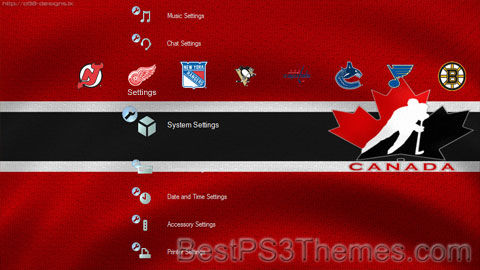
(3 backgrounds)
Hockey is a term used to denote a family of various types of both summer and winter team sports which originated on either an outdoor field, sheet of ice, or dry floor such as in a gymnasium. While these sports vary in specific rules, numbers of players, apparel, and playing surface, they share broad characteristics of two opposing teams using a stick to propel a ball or disk into a goal.
There are many types of hockey. Some games make the use of skates, either wheeled or bladed, while others do not. In order to help make the distinction between these various games, the word hockey is often preceded by another word i.e. field hockey, ice hockey, roller hockey, rink hockey, or floor hockey.
In each of these sports, two teams play against each other by trying to manoeuvre the object of play, either a type of ball or a disk (such as a puck), into the opponent's goal using a hockey stick. Two notable exceptions use a straight stick and an open disk (still referred to as a puck) with a hole in the center instead. The first case is a style of floor hockey whose rules were codified in 1936 during the Great Depression by Canada's Sam Jacks. The second case involves a variant which was later modified in roughly the 1970s to make a related game that would be considered suitable for inclusion as a team sport in the newly emerging Special Olympics. The floor game of gym ringette, though related to floor hockey, is not a true variant due to the fact that it was designed in the 1990s and modelled off of the Canadian ice skating team sport of ringette, which was invented in Canada in 1963. Ringette was also invented by Sam Jacks, the same Canadian who codified the rules for the open disk style of floor hockey 1936.
Certain sports which share general characteristics with the forms of hockey, but are not generally referred to as hockey include lacrosse, hurling, camogie, and shinty.
The first recorded use of the word hockey is in the 1773 book Juvenile Sports and Pastimes, to Which Are Prefixed, Memoirs of the Author: Including a New Mode of Infant Education by Richard Johnson (Pseud. Master Michel Angelo), whose chapter XI was titled "New Improvements on the Game of Hockey".[1] The belief that hockey was mentioned in a 1363 proclamation by King Edward III of England[2] is based on modern translations of the proclamation, which was originally in Latin and explicitly forbade the games "Pilam Manualem, Pedivam, & Bacularem: & ad Canibucam & Gallorum Pugnam".[3][4] The English historian and biographer John Strype did not use the word "hockey" when he translated the proclamation in 1720, instead translating "Canibucam" as "Cambuck";[5] this may have referred to either an early form of hockey or a game more similar to golf or croquet.[6]
The word hockey itself is of unknown origin. One supposition is that it is a derivative of hoquet, a Middle French word for a shepherd's stave.[7] The curved, or "hooked" ends of the sticks used for hockey would indeed have resembled these staves, and similar folk etymologies exist for the bat-and-ball sports of Croquet and Cricket. Another supposition derives from the known use of cork bungs (stoppers), in place of wooden balls to play the game. The stoppers came from barrels containing "hock" ale, also called "hocky".[8]


In most of the world, the term hockey when used without clarification refers to field hockey, while in Canada, the United States, Russia and most of Eastern and Northern Europe, the term usually refers to ice hockey.[9]
In more recent history, the word "hockey" is used in reference to either the summer Olympic sport of field hockey, which is a stick and ball game, and the winter ice team skating sports of bandy and ice hockey. This is due to the fact that field hockey and other stick and ball sports and their related variants preceded games which would eventually be played on ice with ice skates, namely bandy and ice hockey, as well as sports involving dry floors such as roller hockey and floor hockey. However, the "hockey" referred to in common parlance often depends on locale, geography, and the size and popularity of the sport involved. For example, in Europe, "hockey" more typically refers to field hockey, whereas in Canada, it typically refers to ice hockey. In the case of bandy, the game was initially called "hockey on the ice" and preceded the organization and development of ice hockey, but was officially changed to "bandy" in the early 20th century in order to avoid confusion with ice hockey, a separate sport. Bandy, while related to other hockey games, derives some of its inspiration from Association football.
Sledge hockey, a variant of ice hockey designed for players with physical disabilities, was created in the 1960s and has since been renamed, "Para-ice hockey".[10]
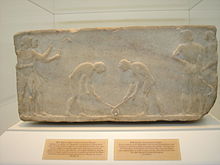
Games played with curved sticks and a ball can be found in the histories of many cultures. In Egypt, 4000-year-old carvings feature teams with sticks and a projectile, hurling dates to before 1272 BC in Ireland, and there is a depiction from approximately 600 BC in Ancient Greece, where the game may have been called kerētízein (κερητίζειν) because it was played with a horn or horn-like stick (kéras, κέρας).[11] In Inner Mongolia, the Daur people have been playing beikou, a game similar to modern field hockey, for about 1,000 years.[12]
Most evidence of hockey-like games during the Middle Ages is found in legislation concerning sports and games. The Galway Statute enacted in Ireland in 1527 banned certain types of ball games, including games using "hooked" (written "hockie", similar to "hooky") sticks.[13]
...at no tyme to use ne occupye the horlinge of the litill balle with hockie stickes or staves, nor use no hande ball to play withoute walles, but only greate foote balle[14]
Bandy, ». a game, like that of Golf, in which the ad- verse parties endeavour to beat a ball (generally a knob or gnarl from the trunk of a tree,) opposite ways...the stick with which the game is played is crook'd at the end.[15]
By the 19th century, the various forms and divisions of historic games began to differentiate and coalesce into the individual sports defined today. Organizations dedicated to the codification of rules and regulations began to form, and national and international bodies sprang up to manage domestic and international competition.
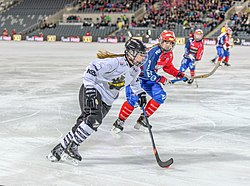
Bandy is played with a ball on a football pitch-sized ice arena (bandy rink), typically outdoors, and with many rules similar to association football. It is played professionally in Russia and Sweden. The sport is recognized by the IOC; its international governing body is the Federation of International Bandy.
Bandy has its roots in England in the 19th century, was originally called "hockey on the ice",[16] and spread from England to other European countries around 1900; a similar Russian sport can also be seen as a predecessor and in Russia, bandy is sometimes called "Russian hockey". Bandy World Championships have been played since 1957 and Women's Bandy World Championships since 2004. There are national club championships in many countries and the top clubs in the world play in the Bandy World Cup every year.

Field hockey is played on gravel, natural grass, or sand-based or water-based artificial turf, with a small, hard ball approximately 73 mm (2.9 in) in diameter. The game is popular among both men and women in many parts of the world, particularly in Europe, Asia, Australia, New Zealand, South Africa, and Argentina. In most countries, the game is played between single-sex sides, although they can be mixed-sex.
The governing body is the 126-member International Hockey Federation (FIH). Men's field hockey has been played at each Summer Olympic Games since 1908 except for 1912 and 1924, while women's field hockey has been played at the Summer Olympic Games since 1980.
Modern field hockey sticks are constructed of a composite of wood, glass fibre or carbon fibre (sometimes both) and are J-shaped, with a curved hook at the playing end, a flat surface on the playing side and a curved surface on the rear side. All sticks are right-handed – left-handed sticks are not permitted.
While field hockey in its current form appeared in mid-18th century England, primarily in schools, it was not until the first half of the 19th century that it became firmly established. The first club was created in 1849 at Blackheath in south-east London. Field hockey is the national sport of Pakistan.[17] It was the national sport of India until the Ministry of Youth Affairs and Sports declared in August 2012 that India has no national sport.[18]
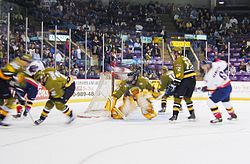
Ice hockey is played between two teams of skaters on a large flat area of ice, using a three-inch-diameter (76.2 mm) vulcanized rubber disc called a puck. This puck is often frozen before high-level games to decrease the amount of bouncing and friction on the ice. The game is played all over North America, Europe and to varying extents in many other countries around the world. It is the most popular sport in Canada, Finland, Latvia, the Czech Republic, and Slovakia. Ice hockey is the national sport of Latvia[19] and the national winter sport of Canada.[20] Ice hockey is played at a number of levels, by all ages.
The governing body of international play is the 77-member International Ice Hockey Federation (IIHF). Men's ice hockey has been played at the Winter Olympics since 1924, and was in the 1920 Summer Olympics. Women's ice hockey was added to the Winter Olympics in 1998. North America's National Hockey League (NHL) is the strongest professional ice hockey league, drawing top ice hockey players from around the globe. The NHL rules are slightly different from those used in Olympic ice hockey over many categories. International ice hockey rules were adopted from Canadian rules in the early 1900s.[21]
The contemporary sport developed in Canada from European and native influences. These included various stick and ball games similar to field hockey, bandy and other games where two teams push a ball or object back and forth with sticks. These were played outdoors on ice under the name "hockey" in England throughout the 19th century, and even earlier under various other names.[22] In Canada, there are 24 reports[23] of hockey-like games in the 19th century before 1875 (five of them using the name "hockey"). The first organized and recorded game of ice hockey was played indoors in Montreal, Quebec, Canada, on March 3, 1875, and featured several McGill University students.
Ice hockey sticks are long L-shaped sticks made of wood, graphite, or composites with a blade at the bottom that can lie flat on the playing surface when the stick is held upright and can legally curve either way, for left- or right-handed players.[24]
Ice sledge hockey, or "para ice hockey", is a form of ice hockey designed for players with physical disabilities affecting their lower bodies. Players sit on double-bladed sledges and use two sticks; each stick has a blade at one end and small picks at the other. Players use the sticks to pass, stickhandle and shoot the puck, and to propel their sledges. The rules are very similar to IIHF ice hockey rules.[25]
Canada is a recognized international leader in the development of sledge hockey, and much of the equipment for the sport was first developed there, such as sledge hockey sticks laminated with fiberglass, as well as aluminum shafts with hand-carved insert blades and special aluminum sledges with regulation skate blades.
Based on ice sledge hockey, inline sledge hockey is played to the same rules as inline puck hockey (essentially ice hockey played off-ice using inline skates). There is no classification point system dictating who can play inline sledge hockey, unlike the situation with other team sports such as wheelchair basketball and wheelchair rugby. Inline sledge hockey is being developed to allow everyone, regardless of whether they have a disability or not, to complete up to world championship level based solely on talent and ability.[citation needed]
The first game of organized inline sledge hockey was played at Bisley, Surrey, England, on December 19, 2009, between the Hull Stingrays and the Grimsby Redwings. Matt Lloyd is credited with inventing inline sledge hockey, and Great Britain is seen as the international leader in the game's development.


Though inline hockey is considered a variant of roller hockey a.k.a. "rink hockey", it was derived from ice hockey instead and uses a type of hockey puck or a ball. Both roller games use a type of wheeled skate but inline hockey uses inline skates rather than roller skates or "quads".
The puck-based inline variant is more commonly played in North America than Europe while the ball-based variant is more popular in Europe.
Inline hockey puck variant is played by two teams, consisting of four skaters and one goalie, on a dry rink divided into two halves by a center line, with one net at each end of the rink. The game is played in three 15-minute periods with a variation of the ice hockey off-side rule. Icings are also called, but are usually referred to as illegal clearing.[26] The governing body is the International Ice Hockey Federation (IIHF), just as it is for ice hockey, but some leagues and competitions do not follow the IIHF regulations, in particular USA Inline and Canada Inline.
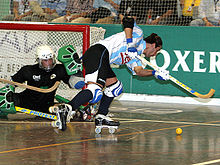
Roller hockey, also known as "quad hockey", "international-style ball hockey", "rink hockey" and "Hoquei em Patins", is an overarching name for a roller sport that uses quad skates. It has existed long before the invention of inline skates. The sport is played in over sixty countries and has a worldwide following. Roller hockey was a demonstration sport at the 1992 Barcelona Summer Olympics.
Also known as road hockey, this is a dry-land variant of ice and roller hockey played year-round on a hard surface (usually asphalt). A ball is usually used instead of a puck, and protective equipment is not usually worn.
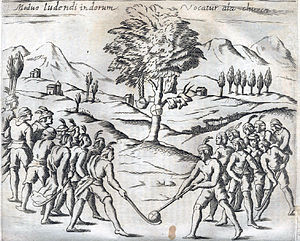
Other games derived from hockey or its predecessors include the following:
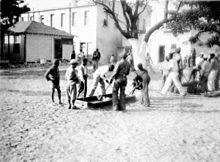
NHL theme by bluezfan8
Download: NHL_3.p3t

(1 background)
Redirect to:
This page is a redirect. The following categories are used to track and monitor this redirect:
|
AS Roma theme by Matthew Agostino
Download: ASRoma.p3t
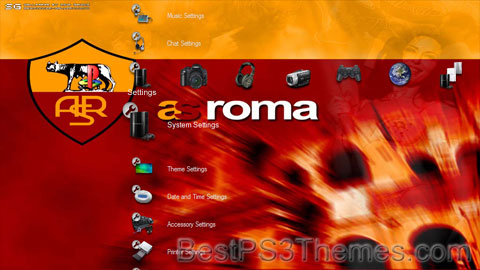
(7 backgrounds)
 | ||||
| Full name | Associazione Sportiva Roma S.p.A. | |||
|---|---|---|---|---|
| Nickname(s) | I Giallorossi (The Yellow and Reds) La Lupa (The She-Wolf) La Magica (The Magic One) Capitolini (Capitoline) Lupetti (Little Cubs) Lupi (Wolves) | |||
| Founded | 7 June 1927 (as Italo Foschi) | |||
| Ground | Stadio Olimpico | |||
| Capacity | 70,634[1] | |||
| Owner | The Friedkin Group (95.97%) | |||
| President | Dan Friedkin | |||
| Head coach | Daniele De Rossi | |||
| League | Serie A | |||
| 2023–24 | Serie A, 6th of 20 | |||
| Website | Club website | |||
|
| ||||
Associazione Sportiva Roma (Rome Sport Association; Italian pronunciation: [ˈroːma]) is a professional football club based in Rome, Italy. Founded by a merger in 1927, Roma has participated in the top tier of Italian football for all of its existence, except for the 1951–52 season. Roma has won Serie A three times, in 1941–42, 1982–83 and 2000–01, as well as nine Coppa Italia titles and two Supercoppa Italiana titles. In European competitions, Roma won the Inter-Cities Fairs Cup in 1960–61 and the UEFA Europa Conference League in 2021–22, while they finished runners-up in the 1983–84 European Cup, the 1990–91 UEFA Cup and the 2022–23 UEFA Europa League.
Sixteen players have won the FIFA World Cup while playing at Roma: Attilio Ferraris and Enrique Guaita (1934); Guido Masetti and Eraldo Monzeglio (1934 and 1938); Aldo Donati and Pietro Serantoni (1938); Bruno Conti (1982); Rudi Völler and Thomas Berthold (1990); Aldair (1994); Vincent Candela (1998); Cafu (2002); Daniele De Rossi, Simone Perrotta and Francesco Totti (2006); Paulo Dybala (2022).
Since 1953, Roma has played home matches at the Stadio Olimpico, a venue the club shares with city rivals Lazio. With a capacity of over 72,000, the stadium is the second-largest of its kind in Italy, with only the San Siro able to seat more. The club plans to move to a new stadium, though it is yet to start construction. Having a strong local rivalry, Roma and Lazio contest the Derby della Capitale.
The club's home colours are carmine red and golden yellow, which gives Roma its nickname "I Giallorossi" ("The Yellow and Reds"). These colours have often been combined with white shorts. The club badge features a she-wolf, an allusion to the founding myth of Rome.

AS Roma was founded in the spring of 1927 when Italo Foschi[2] initiated the merger of three older Italian Football Championship clubs from the city of Rome: Roman FC, SS Alba-Audace and Fortitudo-Pro Roma SGS.[2] Foschi was an important Roman representative of the ruling National Fascist Party.[3][4]
The purpose of the merger was to give the Italian capital a strong club to rival that of the more dominant Northern Italian clubs of the time.[2] The only major Roman club to resist the merger was Lazio because of the intervention of the army General Vaccaro, a member of the club and executive of Italian Football Federation (FIGC). All three founding clubs were relegated, but the fascist-aligned FIGC bet over the capacity of the new team to give a stronger representation to the capital of Italy, and they were awarded a wild card for the Divisione Nazionale, the Serie A forerunner. The club played its earliest seasons at the Motovelodromo Appio stadium,[5] before settling in the working-class streets of Testaccio, where it built an all-wooden ground Campo Testaccio; this was opened in November 1929.[6] An early season in which Roma made a large mark was the 1930–31 championship, where the club finished as runners-up behind Juventus.[7] Captain Attilio Ferraris, along with Guido Masetti, Fulvio Bernardini and Rodolfo Volk, were highly important players during this period.[8]

After a slump in league form and the departure of high key players, Roma eventually rebuilt their squad, adding goalscorers such as the Argentine Enrique Guaita.[9] Under the management of Luigi Barbesino, the Roman club came close to their first title in 1935–36, finishing just one point behind champions Bologna.[10]
Roma returned to form after being inconsistent for much of the late 1930s. Roma recorded an unexpected title triumph in the 1941–42 season by winning their first scudetto title.[11] The 18 goals scored by local player Amedeo Amadei were essential to the Alfréd Schaffer-coached Roma side winning the title. At the time, Italy was involved in World War II and Roma were playing at the Stadio Nazionale PNF.[12]
In the years just after the war, Roma were unable to recapture their league stature from the early 1940s. Roma finished in the lower half of Serie A for five seasons in a row, before eventually succumbing to their only ever relegation to Serie B at the end of the 1950–51 season,[7][13] around a decade after their championship victory. Under future Italy national team manager Giuseppe Viani, promotion straight back up was achieved.[14]
After returning to the Serie A, Roma managed to stabilise themselves as a top-half club again with players such as Egisto Pandolfini, Dino da Costa and Dane Helge Bronée.[7] Their best finish of this period was under the management of Englishman Jesse Carver, when in 1954–55, they finished as runners-up after Udinese, who originally finished second, were relegated for corruption.[7] Although Roma were unable to break into the top four during the following decade, they did achieve some measure of cup success. Their first honour outside of Italy was recorded in 1960–61 when Roma won the Inter-Cities Fairs Cup by defeating Birmingham City 4–2 in the finals.[15] A few years later, Roma won their first Coppa Italia trophy in 1963–64 after defeating Torino 1–0.[16]
Their lowest point came during the 1964–65 season, when manager Juan Carlos Lorenzo announced the club could not pay its players and was unlikely to be able to afford to travel to Vicenza to fulfil its next fixture. Supporters kept the club going with a fundraiser at the Sistine Theatre and bankruptcy was avoided with the election of a new club president Franco Evangelisti.
Their second Coppa Italia trophy was won in 1968–69, when it competed in a small, league-like system.[16] Giacomo Losi set a Roma appearance record in 1969 with 450 appearances in all competitions, a record that would last 38 years.[17]

Roma were able to add another cup to their collection in 1972, with a 3–1 victory over Blackpool in the Anglo-Italian Cup.[18] During much of the 1970s, Roma's appearance in the top half of Serie A was sporadic. The best place the club were able to achieve during the decade was third in 1974–75.[7] Notable players who turned out for the club during this period included midfielders Giancarlo De Sisti and Francesco Rocca.
The dawning of a newly successful era in Roma's footballing history was brought in with another Coppa Italia victory; they defeated Torino on penalties to win the 1979–80 edition.[16] Roma would reach heights in the league which they had not touched since the 1940s by narrowly and controversially finishing as runners-up to Juventus in 1980–81.[19] Former Milan player Nils Liedholm was the manager at the time, with players such as Bruno Conti, Agostino Di Bartolomei, Roberto Pruzzo and Falcão.[20]
The second scudetto did not elude Roma for much longer. In 1982–83, the Roman club won the title for the first time in 41 years, amidst celebrations in the capital.[21] The following season, Roma finished as runners-up in Italy[7] and collected a Coppa Italia title;[16] they also finished as runners-up in the European Cup final of 1984.[22] The European Cup final with Liverpool ended in a 1–1 draw with a goal from Pruzzo, but Roma eventually lost in the penalty shoot-out.[22] Roma's successful run in the 1980s would finish with a runners-up spot in 1985–86[7] and a Coppa Italia victory, beating out Sampdoria 3–2.[16]
After, a comparative decline began in the league, one of the few league highs from the following period being a third-place finish in 1987–88.[7] At the start of the 1990s, the club was involved in an all-Italian UEFA Cup final, where they lost 2–1 to Internazionale in 1991.[23] The same season, the club won its seventh Coppa Italia[16] and ended runners-up to Sampdoria in the Supercoppa Italiana. Aside from finishing runners-up to Torino in a Coppa Italia final,[16] the rest of the decade was largely sub-par in the history of Roma, particularly in the league, where the highest they could manage was fourth in 1997–98.[7] The early 1990s also saw the emergence of homegrown striker Francesco Totti, who would go on to be an important member of the team and the club's iconic captain.
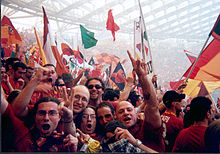
Roma won their third Serie A title in 2000–01. The Scudetto was won on the last day of the season after defeating Parma 3–1, edging Juventus by two points.[7] The club's captain, Francesco Totti, was a large reason for the title victory and he would become one of the main heroes in the club's history,[20] going on to break several club records.[20] Other important players during this period included: Aldair, Cafu, Gabriel Batistuta and Vincenzo Montella.[24]
In the 2001–02 Serie A, Roma ended as runners-up to Juventus by one point.[7] This would be the start of Roma finishing as runners-up several times in both Serie A and Coppa Italia during the 2000s – they lost out 4–2 to Milan in the Coppa Italia final of 2003[16] and lost to Milan again by finishing second in Serie A for the 2003–04 season.[7] The club also re-capitalized several time in 2003–04 season. In November 2003, €37.5 million was injected by "Roma 2000" to cover the half-year loss and loss carried from previous year.[25] and again on 30 June for €44.57 million.[26] Through stock market, a further €19.850 million of new shares issued, and at the year end, the share capital was €19.878 million,[27] which was unchanged as of 2011[update]. The following season also saw the departure of Walter Samuel for €25 million and Emerson for €28 million, which decreased the strength of the squad. The Giallorossi finished in eighth place, one of the worst of recent seasons.

On 9 July 2006, Roma's Francesco Totti, Daniele De Rossi and Simone Perrotta were part of the Italy national team which defeated France in the 2006 FIFA World Cup Final.[28] In the Calciopoli scandal of 2006, Roma were not one of the teams involved. After punishments were issued, Roma was re-classified as runners-up for 2005–06,[29] the same season they finished second in the Coppa Italia losing to Internazionale.[16] In the two following seasons, 2006–07 and 2007–08, Roma finished as Serie A runners-up, meaning that in the 2000s, Roma finished in the top two positions more than any other decade in their history.[30] Meanwhile, in the UEFA Champions League during both of these seasons, they reached the quarter-finals before going out to Manchester United. In the 2008–09 Champions League, Roma reached the knockout stage ahead of Chelsea in their group, thus finishing for the first time in their history as winners of the group stage. However, they lost to Arsenal in the knockout stage on penalty kicks.
After a disappointing start to the 2009–10 season, Claudio Ranieri replaced Luciano Spalletti as head coach. At the time of the switch, Roma lay bottom of the Serie A table after losses to Juventus and Genoa. Despite this setback, Roma went on unbeaten streak of 24 matches in the league – with the last of the 24 being a 2–1 win over rivals Lazio, whereby they came from 1–0 down at half-time to defeat their city rivals after Ranieri substituted both Totti and De Rossi at the interval.[31] The Giallorossi were on top of the table at one point, before a loss to Sampdoria later in the season. Roma would finish runners-up to Internazionale yet again in both Serie A and the Coppa Italia. During the 2000s, Roma had finally recaptured the Scudetto, two Coppa Italia trophies, and their first two Supercoppa Italiana titles. Other notable contributions to the club's history have included a return to the Champions League quarter-finals (in the 2006–07 and 2007–08 editions) since 1984, six runners up positions in the league, four Coppa Italia finals and three Supercoppa finals – marking Roma's greatest ever decade.
Star Du Foot theme by itachi1986
Download: StarDuFoot.p3t
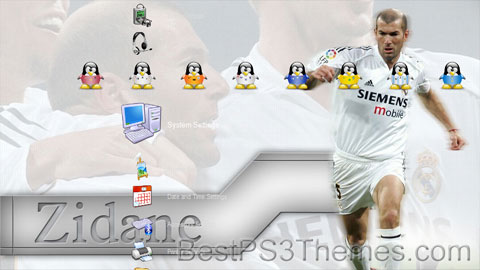
(4 backgrounds)
P3T Unpacker v0.12
Copyright (c) 2007. Anoop Menon
This program unpacks Playstation 3 Theme files (.p3t) so that you can touch-up an existing theme to your likings or use a certain wallpaper from it (as many themes have multiple). But remember, if you use content from another theme and release it, be sure to give credit!
Download for Windows: p3textractor.zip
Instructions:
Download p3textractor.zip from above. Extract the files to a folder with a program such as WinZip or WinRAR. Now there are multiple ways to extract the theme.
The first way is to simply open the p3t file with p3textractor.exe. If you don’t know how to do this, right click the p3t file and select Open With. Alternatively, open the p3t file and it will ask you to select a program to open with. Click Browse and find p3textractor.exe from where you previously extracted it to. It will open CMD and extract the theme to extracted.[filename]. After that, all you need to do for any future p3t files is open them and it will extract.
The second way is very simple. Just drag the p3t file to p3textractor.exe. It will open CMD and extract the theme to extracted.[filename].
For the third way, first put the p3t file you want to extract into the same folder as p3textractor.exe. Open CMD and browse to the folder with p3extractor.exe. Enter the following:
p3textractor filename.p3t [destination path]Replace filename with the name of the p3t file, and replace [destination path] with the name of the folder you want the files to be extracted to. A destination path is not required. By default it will extract to extracted.filename.
Surf Logos theme by mg3
Download: SurfLogos.p3t
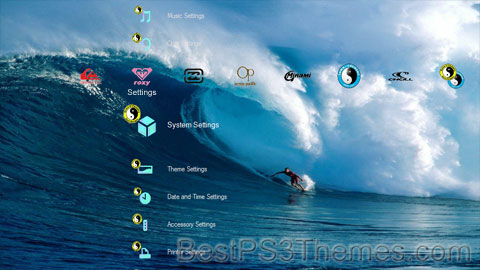
(1 background)
P3T Unpacker v0.12
Copyright (c) 2007. Anoop Menon
This program unpacks Playstation 3 Theme files (.p3t) so that you can touch-up an existing theme to your likings or use a certain wallpaper from it (as many themes have multiple). But remember, if you use content from another theme and release it, be sure to give credit!
Download for Windows: p3textractor.zip
Instructions:
Download p3textractor.zip from above. Extract the files to a folder with a program such as WinZip or WinRAR. Now there are multiple ways to extract the theme.
The first way is to simply open the p3t file with p3textractor.exe. If you don’t know how to do this, right click the p3t file and select Open With. Alternatively, open the p3t file and it will ask you to select a program to open with. Click Browse and find p3textractor.exe from where you previously extracted it to. It will open CMD and extract the theme to extracted.[filename]. After that, all you need to do for any future p3t files is open them and it will extract.
The second way is very simple. Just drag the p3t file to p3textractor.exe. It will open CMD and extract the theme to extracted.[filename].
For the third way, first put the p3t file you want to extract into the same folder as p3textractor.exe. Open CMD and browse to the folder with p3extractor.exe. Enter the following:
p3textractor filename.p3t [destination path]Replace filename with the name of the p3t file, and replace [destination path] with the name of the folder you want the files to be extracted to. A destination path is not required. By default it will extract to extracted.filename.